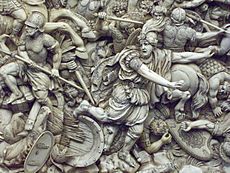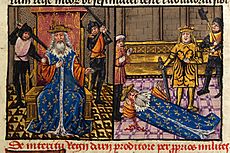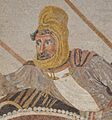Darius III facts for kids
Quick facts for kids Darius III𐎭𐎠𐎼𐎹𐎺𐎢𐏁 |
|
|---|---|
|
|
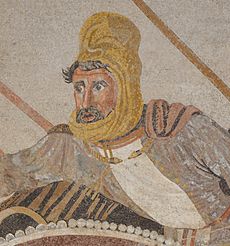
Depiction of Darius III during the Battle of Issus in the Alexander Mosaic (c. 100 BCE), ancient Roman floor mosaic from the House of the Faun in Pompeii, Italy
|
|
| King of Kings of the Achaemenid Empire | |
| Reign | 336–330 BC |
| Predecessor | Artaxerxes IV Arses |
| Successor |
|
| Pharaoh of Egypt | |
| Reign | 336–332 BC |
| Predecessor | Artaxerxes IV |
| Successor | Alexander the Great |
| Born | c. 380 BC |
| Died | July 330 BC (aged approximately 50) Parthia |
| Burial | Persepolis |
| Spouse | Stateira I |
| Issue |
|
| Dynasty | Achaemenid |
| Father | Arsames |
| Mother | Sisygambis |
| Religion | Zoroastrianism |
Darius III (Old Persian: 𐎭𐎠𐎼𐎹𐎺𐎢𐏁 Dārayavaʰuš; Greek: Δαρεῖος Dareios; c. 380 – 330 BC) was the last Achaemenid King of Kings of Persia. He ruled from 336 BC until his death in 330 BC.
Darius III was not a direct heir to the throne, unlike the king before him, Artaxerxes IV Arses. He was a distant relative of the Achaemenid dynasty. Early in his career, he was not well-known. He first gained attention during a military campaign led by Artaxerxes III in the 350s BC. For his bravery, he was given control of the region of Satrapy of Armenia. Around 340 BC, he was put in charge of the royal "postal service," which was a very important job.
In 338 BC, Artaxerxes III died suddenly, poisoned by a court official named Bagoas. Bagoas then put Artaxerxes' youngest son, Arses, on the throne. Arses ruled for only a few years before Bagoas poisoned him too. Darius was then made king. Soon after, Darius found out that Bagoas planned to poison him as well. Darius then forced Bagoas to drink his own poison.
In 334 BC, Alexander the Great began his invasion of the Persian Empire. Alexander defeated the Persians in several battles. He then looted and destroyed their capital city, Persepolis, by fire in 330 BC. With the Persian Empire now largely under Alexander's control, Alexander decided to chase Darius. However, before Alexander could reach him, Darius was killed by his relative Bessus. Bessus was also the governor of Bactria.
Darius is remembered in some Iranian stories as Dara II. He is seen as the last king of a legendary dynasty, which reflects memories of the Achaemenid kings.
Contents
Who Was Darius III?
Darius was born around 380 BC. He was a distant relative of the royal Achaemenid dynasty. His father was Arsames, and his grandfather was Ostanes. Ostanes' father, Darius II, ruled the Achaemenid Empire from 424 BC to 405 BC. Darius III's mother was Sisygambis. She was likely also from the Achaemenid family. Darius had a brother named Oxyathres and a sister named Stateira I.
Early Life and Rise to Power
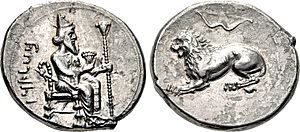
Before he became king, Darius was known as Artashata. He first became known during a military campaign against the Cadusii people. This was led by Artaxerxes III in the 350s BC. During a battle, Artashata showed great courage by defeating an enemy warrior in a one-on-one fight. Artaxerxes III noticed his bravery and rewarded him with gifts. He also made him the governor of Satrapy of Armenia.
After this promotion, Artashata likely married for the first time. He had two daughters and possibly a son. Later, Greek writers said that Artashata became the king's "courier" and "servant." This was a high-ranking job, probably in charge of the royal "postal service." This system was used to send messages across the empire.
Around 340 BC, Artashata married his sister, Stateira I. In 339 BC, they had a son named Ochus. This shows that Artaxerxes III, who was careful about relatives who might challenge his rule, did not see Artashata as a threat.
In 338 BC, a court official named Bagoas arranged for Artaxerxes III to be poisoned. Most of Artaxerxes III's sons were also killed by Bagoas. Bagoas then put the young Arses (Artaxerxes IV) on the throne. Arses tried to free himself from Bagoas's control. He tried to poison Bagoas, but Bagoas found out. Bagoas then poisoned Arses and his family. In 336 BC, Bagoas made Artashata king. Artashata was known for his bravery and was likely from a royal family. This helped him gain support from the nobles.
Conflict with the Greeks
Philip's Campaign
Soon after becoming king, Darius III discovered that Bagoas was trying to poison him. Darius III forced Bagoas to drink the poisoned cup himself, leading to Bagoas's death. This happened around the same time that Alexander became king of Macedon in 336 BC.
In 336 BC, Philip II of Macedon was given permission by the League of Corinth to start a war against the Persians. This was to get revenge for the Persians burning Athenian temples during the Second Persian War over a century earlier. Philip sent an army into Asia Minor to free the Greeks living under Persian rule. After they captured Greek cities, Philip was killed. His campaign was paused while his son, Alexander, took control of Macedon.
Alexander's Campaign
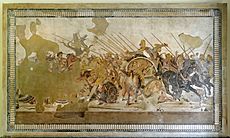
In the spring of 334 BC, Alexander, Philip's son, invaded Asia Minor. He led an army of Macedonian and other Greek soldiers. This invasion began the Wars of Alexander the Great. Alexander quickly won a victory over the Persians at the Battle of the Granicus. Darius did not attend this battle. He likely thought that his local governors could handle the problem. He stayed in his capital, Persepolis.
Darius did not face Alexander's army until a year and a half after Granicus. This was at the Battle of Issus in 333 BC. Darius's army was much larger than Alexander's, but Alexander still outsmarted and defeated him. Darius was forced to run away. Stories say that Darius fled quickly, leaving behind his chariot, bow, and royal robe. Alexander later found these items.
Greek writers say that Darius fled out of fear at the Battle of Issus. He did the same two years later at the Battle of Gaugamela. Both times, he had a larger army and a good defensive position. At Issus, Darius even surprised Alexander but still failed to win. Darius fled so fast that Alexander captured his headquarters and took Darius's family prisoner. Darius sent letters to Alexander asking for his family back. Alexander refused unless Darius recognized him as the new emperor of Persia.
The situation seemed better for Darius at the Battle of Gaugamela in 331 BC. He had many well-organized troops. He also had support from armies of several governors. The battlefield was flat, which was good for his chariots. Despite these advantages, he still fled the battle before a winner was clear. He left his experienced commanders and one of the largest armies ever gathered. Many Persian soldiers died that day. After this battle, Darius could not gather another large imperial army.
Darius then fled to Ecbatana and tried to raise a third army. Meanwhile, Alexander took control of Babylon, Susa, and the Persian capital at Persepolis. Darius reportedly offered Alexander all of his empire west of the Euphrates River for peace. Alexander refused these offers, even though his commanders advised him to accept. Alexander could have stopped after capturing Persepolis, but he chose to pursue Darius instead.
The Battle of Gaugamela, where Alexander defeated Darius III, happened about 100 kilometers (62 miles) west of Erbil, Iraq. After the battle, Darius escaped to the city. The battle is sometimes called the "Battle of Arbela," though this is not entirely accurate.
Flight and Death
Darius tried to rebuild his army after his defeat by Alexander. However, he could not gather a force as strong as the one at Gaugamela. This was partly because his authority was weakened. Also, Alexander's policies in places like Babylonia offered a good alternative to Persian rule.
When Darius was in Ecbatana, he learned that Alexander's army was coming closer. He decided to retreat to Bactria. He thought he could use his cavalry and hired soldiers better on the flat plains there. He led his army through the Caspian Gates, a mountain pass that would slow down Alexander's army.
Persian soldiers became discouraged. They constantly feared a surprise attack from Alexander. This led to many soldiers leaving the army. Eventually, a plot was formed against Darius. It was led by Bessus, a governor, and Nabarzanes, who managed the king's meetings and palace guard. They suggested that Bessus take charge of the army. They said power would be given back to Darius after Alexander was defeated. Darius did not agree to this plan. The plotters became more eager to remove him because of his repeated failures against Alexander.
A Greek soldier named Patron urged Darius to use Greek mercenaries as bodyguards instead of his usual Persian guards. This was to protect him from Bessus and Nabarzanes. However, Darius could not accept this for political reasons. He seemed to accept his fate. Bessus and Nabarzanes eventually tied Darius up and put him in an ox-cart. They ordered the Persian forces to keep moving.
According to the historian Curtius, Alexander and a small, fast group of soldiers arrived at this point. They caused panic among the Persians. Bessus and two other plotters, Satibarzanes and Barsaentes, wounded Darius with their spears and left him to die.
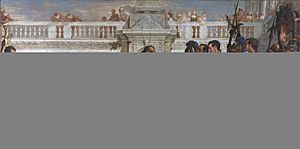
A Macedonian soldier found Darius either dead or dying in the wagon shortly after. Alexander was disappointed because he wanted to capture Darius alive. Alexander saw Darius's dead body in the wagon and took the king's signet ring. He then sent Darius's body back to Persepolis. Alexander gave him a grand funeral and ordered him to be buried in the royal tombs, like all his royal ancestors. Darius's tomb has not yet been found. Alexander later married Darius's daughter, Stateira II, in Susa in 324 BC.
With the old king defeated and properly buried, Alexander's rule over Persia became official. Some historians view Darius as cowardly and ineffective. Under his rule, the entire Persian Empire fell to a foreign invader. After killing Darius, Bessus took the royal name Artaxerxes V and called himself the King of Asia. Alexander later captured Bessus and had him executed.
Images for kids
See also
 In Spanish: Darío III para niños
In Spanish: Darío III para niños


